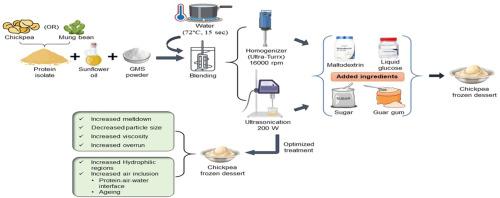Comparative study between conventional and ultrasonic homogenization techniques on the formulated vegan frozen dessert made using chickpea and mung bean protein isolates
引用次数: 0
Abstract
This work is on the substitution of milk protein and milk fat with legume protein and vegetable oil for the preparation of frozen desserts, which are non-dairy alternatives to lactose-intolerant populations. The main objective of this study is to compare ultrasound (US) homogenization and conventional homogenization (high shear homogenization using the ultra-turrax (UT) technique) in the preparation of frozen desserts using chickpea and mung bean protein isolates. UT and US at varying time conditions have been used to make ice cream mix emulsion. Optical microscopy was used to assess the size distribution of fat globules to evaluate homogenization. Chickpea frozen dessert samples at US 6 min and UT 7.5 min were found to be the best samples with better functional characteristics when compared to the mung bean frozen dessert. Reduction and uniformity in particle size have a remarkable effect on melting resistance, air incorporation, and viscosity. In general, ultrasound has a very effective homogenization impact compared with traditional homogenization. Outcomes from this research showed that a selective homogenization condition for formulated frozen desserts (FFD) is achievable without developing structural problems and gives better results.

用鹰嘴豆和绿豆分离蛋白配制纯素冷冻甜点的常规和超声均质技术比较研究
这项工作是用豆类蛋白和植物油代替牛奶蛋白和牛奶脂肪来制备冷冻甜点,这是乳糖不耐症人群的非乳制品替代品。本研究的主要目的是比较超声(US)均质法和常规均质法(使用超turrax (UT)技术的高剪切均质法)在制备鹰嘴豆和绿豆分离蛋白冷冻甜点中的应用。用UT和US在不同时间条件下制备冰淇淋混合乳剂。使用光学显微镜评估脂肪球的大小分布,以评估均匀性。与绿豆冷冻甜点相比,鹰嘴豆冷冻甜点样品在US 6 min和UT 7.5 min时具有更好的功能特性。颗粒尺寸的减小和均匀性对熔化阻力、空气掺入和粘度有显著的影响。一般来说,与传统的均质相比,超声具有非常有效的均质影响。本研究结果表明,配方冷冻甜点(FFD)的选择性均质条件是可以实现的,而不会产生结构问题,并且效果更好。
本文章由计算机程序翻译,如有差异,请以英文原文为准。
求助全文
约1分钟内获得全文
求助全文
来源期刊

Food chemistry advances
Analytical Chemistry, Organic Chemistry, Chemistry (General), Molecular Biology
CiteScore
1.90
自引率
0.00%
发文量
0
审稿时长
99 days
 求助内容:
求助内容: 应助结果提醒方式:
应助结果提醒方式:


